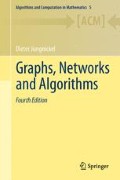Abstract
For practical applications, by far the most useful optimization algorithm for solving linear programs is the celebrated simplex algorithm. This suggests trying to apply this algorithm also to problems from graph theory. Indeed, the most important network optimization problems may be formulated in terms of linear programs; this holds, for instance, for the determination of shortest paths, maximal flows, optimal flows, and optimal circulations. Nevertheless, a direct application of the usual simplex algorithm would make no sense, as the resulting linear programs would be unwieldy and highly degenerate. These two problems are avoided by using a suitable graph theoretic specialization of the simplex algorithm, the so-called network simplex algorithm. This algorithm is usually formulated in terms of a standard problem which we will introduce in the first section; all other problems of practical interest admit easy transformations to this problem. Throughout this book, we emphasize the graph theoretical aspects of combinatorial optimization while avoiding the theory of linear programming as much as possible. In view of this philosophy, it is very fortunate that the network simplex algorithm may be dealt with entirely in graph theoretic terms, with no need to appeal to linear programming; such a presentation will be given here.
O sancta simplicitas!
John Huss
Access this chapter
Tax calculation will be finalised at checkout
Purchases are for personal use only
Notes
- 1.
The purpose of the constants +1 appearing in the definition of c′ is to make the auxiliary problem nondegenerate.
- 2.
By analogy with Chap. 6, a path W from v to t is called an augmenting path with respect to g if g(e)<c(e) holds for every forward edge e∈W, and g(e)>b(e) holds for every backward edge e∈W.
- 3.
The approach of Theorem 11.3.1 corresponds to the big-M method in linear programming. There is a major difference, though: for an MCFP, we can explicitly select a reasonable value of M, whereas for general linear programs M has to be taken really huge—which automatically leads to numerical problems. For instance, with M=1016 and a standard floating point arithmetic accurate to 15 digits, computing a sum M+x with 0<x<10 has no meaning. In other words, the big-M method is of theoretical interest, but not suitable for practical use. In contrast, the method in Theorem 11.3.1 also works very well in practice. A value of M which is so large that it would lead to numerical instability could arise only if some cost values differ by ≈1015/|V|, which is not the case in practical applications.
References
Bazaraa, M.S., Jarvis, J.J., Sherali, H.D.: Linear Programming and Network Flows, 4th edn. Wiley, New York (2010)
Chvátal, V.: Linear Programming. Freeman, New York (1983)
Goldberg, A.V., Grigoriadis, M.D., Tarjan, R.E.: Use of dynamic trees in a network simplex algorithm for the maximum flow problem. Math. Program. 50, 277–290 (1991)
Goldfarb, D., Hao, J.: A primal simplex algorithm that solves the maximum flow problem in at most nm pivots and O(n 2 m) time. Math. Program. 47, 353–365 (1990)
Goldfarb, D., Hao, J.: On strongly polynomial variants of the network simplex algorithm for the maximum flow problem. Oper. Res. Lett. 10, 383–387 (1991)
Orlin, J.B.: A polynomial time primal network simplex algorithm for minimum cost flows. Math. Program. 78, 109–129 (1997)
Tarjan, R.E.: Dynamic trees as search trees via Euler tours applied to the network simplex algorithm. Math. Program. 78, 169–177 (1997)
Author information
Authors and Affiliations
Rights and permissions
Copyright information
© 2013 Springer-Verlag Berlin Heidelberg
About this chapter
Cite this chapter
Jungnickel, D. (2013). The Network Simplex Algorithm. In: Graphs, Networks and Algorithms. Algorithms and Computation in Mathematics, vol 5. Springer, Berlin, Heidelberg. https://doi.org/10.1007/978-3-642-32278-5_11
Download citation
DOI: https://doi.org/10.1007/978-3-642-32278-5_11
Publisher Name: Springer, Berlin, Heidelberg
Print ISBN: 978-3-642-32277-8
Online ISBN: 978-3-642-32278-5
eBook Packages: Mathematics and StatisticsMathematics and Statistics (R0)

